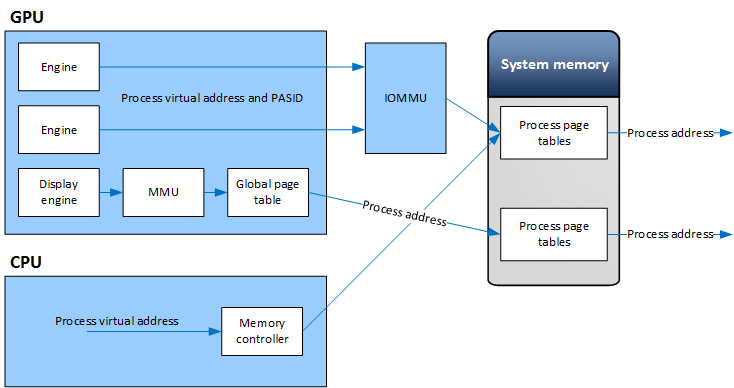IoMmu model
This page describes the IoMmu model introduced in WDDM 2.0. See IOMMU-based GPU isolation and IOMMU DMA remapping for more recent IOMMU updates.
Overview
An Input-Output Memory Management Unit (IOMMU) is an MMU component that connects a DMA-capable I/O bus to system memory. It maps device-visible virtual addresses to physical addresses, making it useful in virtualization.
In the WDDM 2.0 IoMmu model, each process has a single virtual address space that is:
- Shared between the CPU and GPU.
- Managed by the OS memory manager.
To access memory, the GPU sends a data request to a compliant IOMMU. The request includes a shared virtual address and a process address space identifier (PASID). The IOMMU performs the address translation using the shared page table. This action is illustrated in the following diagram.

The kernel-mode display driver (KMD) expresses support for the IoMmu model by setting the DXGK_VIDMMCAPS::IoMmuSupported caps. When this flag is set, the video memory manager (VidMm) automatically registers any process using the GPU with the IOMMU and obtains a PASID for that process address space. The PASID is passed to the driver during device creation.
VidMm maps primary allocations into the aperture segment before being displayed, ensuring that the display controller has physical access to these allocations.
In the IoMmu model, the user-mode display driver (UMD) continues to allocate video memory for the GPU using VidMm's Allocate service. This process allows the UMD to:
- Follow the residency model.
- Support the DirectX resource sharing model.
- Ensure that primary surfaces are visible to the kernel and are mapped into aperture before being displayed.
The UMD entirely manages the first level of translation (tile resource address to shared CPU/GPU address) in user mode.
Feedback
Coming soon: Throughout 2024 we will be phasing out GitHub Issues as the feedback mechanism for content and replacing it with a new feedback system. For more information see: https://aka.ms/ContentUserFeedback.
Submit and view feedback for